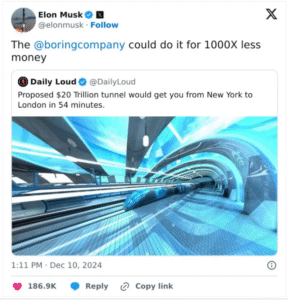Elon Musk Suggests Transatlantic Tunnel Could Be Built at a Fraction of $25 Trillion Cost
For years, the idea of a transatlantic tunnel connecting New York and London has captivated imaginations. The proposed route — spanning roughly 5,500 kilometers — could, in theory, slash travel time between the two cities to just 54 minutes. However, the astronomical cost, initially estimated at $25 trillion, has left the concept stuck in the realm of science fiction.
No company has yet presented a viable plan to make the tunnel a reality — until now. Elon Musk, founder of The Boring Company, claims his firm could achieve the feat at a fraction of the cost. In response to a post on X (formerly Twitter) discussing a hypothetical $20 trillion tunnel, Musk stated:
“The @boringcompany could do that for 1000x less money.”
A Monumental Undertaking
Such a tunnel would dwarf current engineering marvels, including the Channel Tunnel — which took six years to build and spans just 23.5 kilometers. At the same pace, constructing a tunnel across the Atlantic would take an estimated 782 years, according to Newsweek.

Design concepts have ranged from submerged tunnels laid on the seafloor to floating ones suspended by cables — each presenting significant engineering and financial hurdles. As of now, no definitive designs exist.
Musk’s Larger Vision for High-Speed Travel
The transatlantic tunnel isn’t Musk’s only bold transportation idea. Through SpaceX, he has promoted rapid “Earth-to-Earth” travel via Starship rockets. Theoretically, these rockets could transport passengers from London to New York in 30 minutes, New York to Shanghai in 39 minutes, and Zurich to Sydney in 50 minutes.

Still, Musk’s track record with such predictions is mixed. For example, he claimed in 2016 that Tesla would have fully autonomous vehicles by 2017. As of 2024, Tesla’s Autopilot still requires driver supervision. Similarly, his 2020 promise of widespread autonomous robotaxis has yet to be realized.
Progress Elsewhere: The Fehmarnbelt Tunnel
While a transatlantic tunnel remains speculative, other innovative infrastructure projects are advancing. One example is the Fehmarnbelt Tunnel, a Danish-German venture set to open in 2029. Spanning 18 kilometers beneath the Baltic Sea and running more than 40 meters below the surface, it will connect southern Denmark to northern Germany. The project promises faster travel, fewer traffic delays, and improved reliability.
According to Femern A/S spokesperson Denise Juchem, the Fehmarnbelt Tunnel will be “a major step forward in European connectivity.”







Leave a Comment